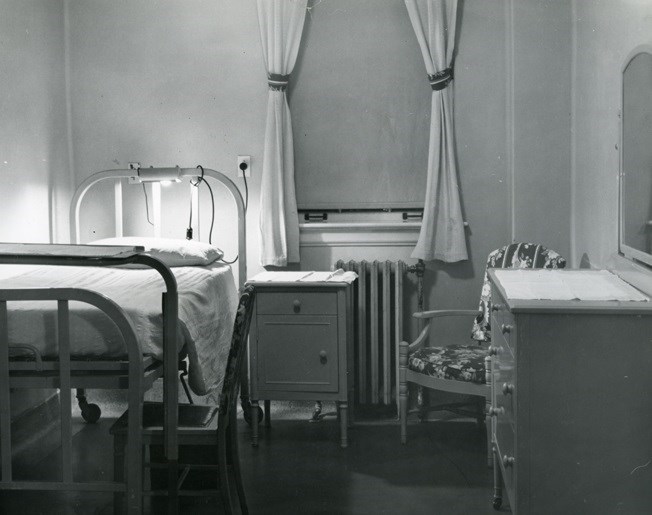From the archives of the Sault Ste. Marie Public Library:
There have been numerous outbreaks of influenza throughout the history of Sault Ste. Marie.
The Spanish Flu pandemic killed 75 residents, out of 255 infected. Then, in 1949, while not reaching pandemic levels, a bad outbreak of the seasonal flu wreaked havoc on the city. The Medical Officer of Health, J.E. Gimby, recommended regular doses of whisky; according to the Globe and Mail, Saultites bought out the local supply, prompting the liquor store “to ask the Ontario Liquor Control Board to hustle up more whisky - or rum - or brandy.”
In February of 1957, a new form of influenza emerged in Singapore and mainland China. This flu, of the subtype H2N2, was a combination of human and avian viruses. By summer, it had reached North America, where journalists speculated on the dangers of viruses spreading via passenger airplanes. More travel meant more opportunities for the virus to spread internationally.
By September of 1957, the virus was first detected in Canada. By this point, the Canadian public would have been well aware of the virus, with news headlines tracking its spread across the globe and reporting on the tens of thousands of deaths.
The newspapers noted, however, that the flu was “very mild.” While the virus had a relatively low fatality rate, what health officials found disturbing was how rapidly it could spread through a community, and the potential for it to disrupt essential services.
Later that month, the flu was making headlines for its impact on Northern Ontario communities. The Globe and Mail reported that Sudbury, at the beginning of the pandemic, was the hardest hit place in Canada, coming in at 6,000 cases. The first three deaths were all located in the north as well: one in Sturgeon Falls, one in Garson, and one in Sault Ste. Marie — the Globe and Mail described the deceased as “an elderly unidentified resident.”
The Sault Star would later report that he was a resident of the F. J. Davey Home for the Aged.
The Globe and Mail reported on school closures, stricken healthcare workers, and concerns that the flu would come roaring back in more deadly waves.
By Oct. 7, 1957, there was a death in Spanish River, this time a teenager. The flu had also hit Sault Ste. Marie, with Medical Officer of Health J.E. Gimby ordering the closure of four schools: Collegiate, the Tech, Sir James Dunn, and Anna McCrea.
This was in direct response to flu absenteeism rates. According to Gimby, once absenteeism reached 25 per cent, the school should be closed. All four schools exceeded that percentage; Anna McCrea was hardest hit, with almost half of all students out with the flu.
As the outbreak began to gather steam, Gimby banned hospital visitors at both the Plummer and the General hospitals, only allowing them in on compassionate grounds to visit critically ill patients. He also ordered swimming and fitness classes to be halted at the YMCA
While he did not have an exact number as to the number of cases in the Sault, he declared the virus to have “positively reached epidemic proportions.”
According to the Sault Star, Gimby’s advice for anyone who caught the Asian Flu was to “go to bed and stay there.” He recommended bed rest — two days for every day they experienced symptoms. He also stressed the need for isolation in preventing the spread of the virus. And, according to the Globe and Mail, once again, his advice was to take doses of brandy.
By Oct. 8, 1957, just one day after the first school closures, 11 more schools in the Sault area had closed, leaving a total of 15 closed. By Oct. 9, all 27 schools were temporarily closed in the face of high influenza numbers.
School officials estimated that the school closures would be temporary, only lasting around a week. During that week, there were already two school holidays — one for Thanksgiving Monday and one to observe the Queen’s visit to Canada — meaning that disruption to students would be minimal.
A Sault Star article also reminded parents that they should “keep children from crowded places” because “large congregations in places of entertainment can be just as dangerous to spreading the flu as attendance at school classes.”
All told, the worldwide death toll varied with the virus killing an estimated 1 to 4 million people worldwide, 7,000 in Canada, making it significantly less deadly than the previous 1918 Spanish Flu pandemic.
By spring of 1958, the virus was no longer considered a pandemic, in part due to a successful vaccination program that marked the first time a vaccine was developed for a pandemic flu. The virus, however, continued to circulate for approximately ten years, during which time it underwent a genetic shift, mutating into a new form.
This new version, H3N2 influenza, became known as the Hong Kong flu. It sparked a pandemic in 1968 that killed approximately one million people worldwide, 4,000 in Canada. The H3N2 strain continues to circulate today as one of the many strains of seasonal influenza.
Each week, the Sault Ste. Marie Public Library and its Archives provides SooToday readers with a glimpse of the city’s past.
Find out more of what the Public Library has to offer at www.ssmpl.ca and look for more Remember This? columns here
